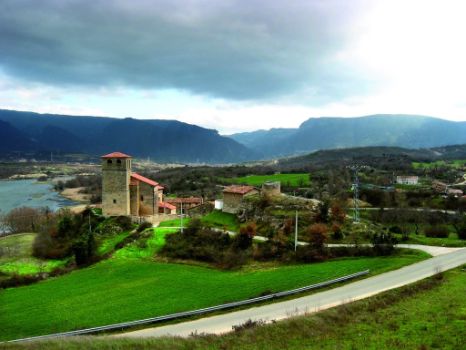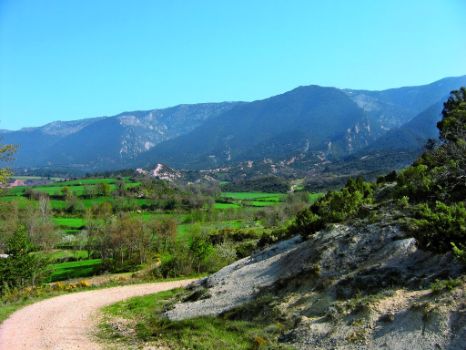Net of Natural
Trails

Stage 10.1: Barcina de Barco - San Martín de Don
Description
Barcina del Barco (520 m) has both a modern church and fine examples of traditional buildings, including large stone mansions with emblazoned façades. From the south of the old town, near the sports centre, begins a paved trail that heads down to the Ebro and merges with access road to Santa María de Garoña nuclear power station. Both this station and the one at Ascó (Tarragona) use water from the Ebro for its cooling systems, creating a thermally-contrasted aquatic microclimate, which produces a less significant anthropogenic landscape.
After crossing the bridge over the Ebro and the tail water of the Sobrón Reservoir, and past the entrance to the power station to the right, the route heads up the road towards the hamlet of Santa María de Garoña that consists of two neighbourhoods on opposite sides of the San Juan Brook (2.6 km, 35min).

The well-preserved sturdy structure of the bell tower, built with stone and adobe, and the farmyards surrounding the ensemble, reflect the charm of yesteryears.
Leaving Santa María behind (through the east end), there is a wide track to the right, between agricultural buildings, known as the road to Pedrera, that gets steeper as it heads up the right slope of San Pedro Brook. At the end of its watershed, at a bend to the right, the route turns onto a stony bridle path (hence its name) that runs along the northern slope.
After skirting the hill, the path rejoins the track (eight minutes). Farmlands, pines, oaks and boxwood add to the extraordinary views of Montes Obarenes to the south (right); Sierra de Arcena and the vast extension of Tobalina Valley, dotted with the towns of Mijaralenga and San Martín de Don to the north (left); Santa María de Garoña and the nuclear power station to the west (behind) and Sobrón Gorge and Reservoir, and the town of Orbañanos straight ahead (east) which may be accessed after crossing Coreo Brook.

Before venturing into the village, the GR 99 leaves the ruins of a church to the right, past a shrine with a porch to the left. The route crosses a small bridge and continues along the access road to the town.
Orbañanos (6 km, 1hr 30min), a town with a proper urban structure and traditional architecture, sits on a mild spur, in the foothills of Montes Obarenes. Without entering the town centre, the route continues 300 m down the road to Tobalinilla, and turns to the right onto a vehicle track. After many twists and turns, it winds down Monte Santullán, crosses Vau Brook and reaches Tobalinilla.
This is a residential village in which new buildings line the roadside along the banks of the Ebro. Its prime location at the beginning of Sobrón Gorge, in the boundary between Burgos and Alava, allows it inhabitants to enjoy a natural landscape of interest. From the folk-style church, the path continues along the road to the bridge over the Sobrón Reservoir, opposite the natural gateway to the gorge.
Entidades gestoras:
- Ministerio de Agricultura, Pesca y Alimentación
Enlaces de interés
Puntos de interés
Infrastructure
Municipality
Hostel
Profile

Highlights
Further information
Bridges - Symbols of Connection
Since ancient times, the need for connection between the opposite banks of the Ebro has led to the construction of different systems (bridges, pontoons and walkways) that, over time, have changed in appearance and materials in line with the architectural style of the time.
The construction of a network of elevated structures began in Roman times, evidenced by the 2nd century Mantible stone bridge in Alava.
In the Middle Ages, the structures and uses diversified. Roman roads or new roads, such as the Way of St. James, run over these structures. They were used as customs houses and provided a perfect defence system. Case in point is Frías Bridge (Burgos), a late 14th or early 15th century construction with a tower at its centre.
Other noteworthy bridges are San Vicente de la Sonsierra (11th C.) and Briñas (13th C.), La Rioja (11th C.), Villanueva-Rampalay (13th C.) and Trespaderne (12th C. Romanesque), both in Burgos, or Piedra de Saragossa (built in the 15th C. over a pre-existing Roman bridge).
In the eighteenth century, new types of connection structures were created under the Enlightenment, such as the bridges of Carlos III in Miranda de Ebro (Burgos) and Reinosa (Cantabria). Variations on the classic form of stone constructions were made during the next two centuries, including the bridge at Logroño (1884), combined with iron. There are other notable examples, such as the Puente de las Arcadas at Gallur (Saragossa), Hierro at Saragossa, and Tortosa (Tarragona), all from the late nineteenth century, and the suspension bridge at Amposta (Tarragona) (1921).
In recent years, innovative and state-of-the-art bridges have been built, including Nuevo Bridge at Logroño, the motorway bridge at Castejón de Ebro (Navarre), Gimenez Abad (Saragossa) or Milenio (Tortosa).




